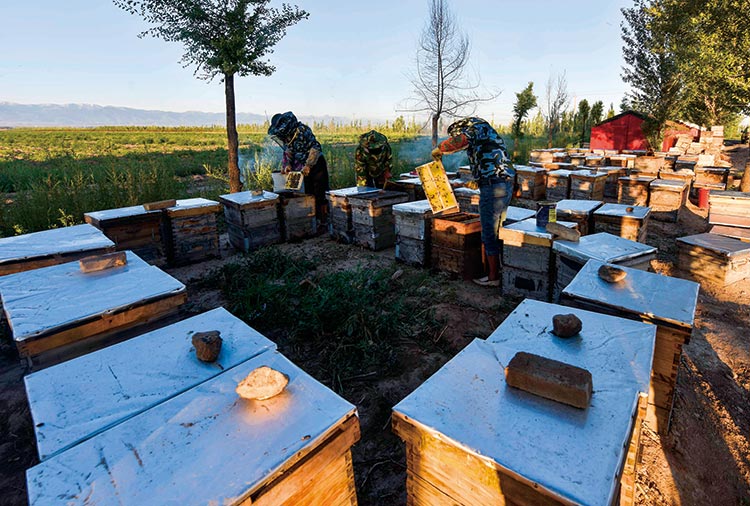Written by: Guan Qiaoqiao
Posted on: October 31, 2018 |  | 中文
| 中文
The beekeepers working in the early hours (Image by Zhao Ge)
By 8 a.m., before the bees leave the hives to collect honey, Zhou Xiaotong, a bee farmer, and his wife Zhou Heying, are busy gathering honey. Hundreds of beehives line up in circles like a flower bud, in a lavender flower field, in Qapqal Xibo Autonomous County, Xinjiang, China. The flying bees and industrious bee farmers are busy working among the flowers to make themselves a "sweet life."
In the blooming season of lavender in Ili River Valley, bee farmers begin to collect aromatic lavender honey. Zhou Xiaotong will not finish the day’s work until 11 at night, when the bees return to the hives.
Ili area of Xinjiang, where Zhou lives, began to introduce and plant lavender in the 1960s, and now its lavender planting area accounts for more than 90% of China's total. Located in the same latitude zone as Provence of France, Ili River Valley enjoys similar climate and soil conditions as the famous French lavender production area. It is the world's third largest lavender planting base after Provence and Furano of Japan. As the only major production area of lavender in China, it has been named the "hometown of lavender in China," by the state department concerned.
The flowering season of lavender is from late May to late July. In one flowering season alone, Zhou can harvest four to five tons of lavender honey. Compared to mountain flower honey, priced at 100 plus yuan per kg, lavender honey is much more expensive, and its market retail price reaches 300 yuan per kg.
"The inside of the hive changes very fast. We must keep checking the hives and removing the wax.” The bee farmer, though rather thin, is very quick with his hands and can complete checking of a box of honeycomb in about ten minutes. In his eyes, diligence is the main secret of raising bees and producing honey. In order to ensure the quality, he takes the lavender honey only once every more than ten days, whereas mountain flower honey is generally taken once every two or three days.

The bee farmer defined his relationship with bees as "mutually feeding" and "interdependent." Speaking of his affection toward bees, Zhou showed mixed feelings. In the 1990s, when honey prices fell, many bee farmers turned to other businesses. He also once contacted buyers, but ultimately pulled back, because of his reluctance to sell his bees. Thereafter, he insisted on beekeeping.
From the 15 bee hives in the beginning to 42, 70 and 300, now the number of Zhou's hives of black bees has increased to more than 650, with about 30 million bees. His transportation vehicle has also changed from donkey carts to tractors, trucks and extended semi-trailers. Now, his transfer radius has expanded from a few kilometers, to tens or even hundreds of kilometers. And for him, cross-region beekeeping has become an ordinary thing.
Yet, beekeeping is still risky. “What we bee farmers are most worried about is the climate. And we once encountered the bad weather period in the flowering period, when it rained for 10 days to a half month. The climate directly determines how much money we can make.” Zhou admitted that bee farming is also a lonely career, since they have to transfer between sparsely populated places in the deep Tianshan Mountains throughout the year.
"Fortunately, the living conditions have gotten better and better over the years. With solar energy, we can watch TV in the mountains; and with cell phone, we can use WeChat. Our spare-time life is getting richer than before.” Zhou said that for him the days are gone when he used kerosene lamps and had nothing to do but to sleep when night fell, and all that was in his past now.
Translated by Xu Donglin
You may also like: